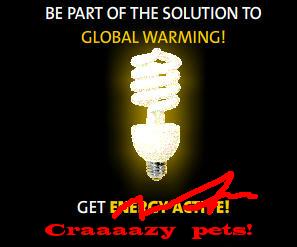I'm usually a pretty patient guy about marketing. Unlike some, I am not educated by it and, unlike others, I don't look down on it. I know why it it exists and I appreciate its value but at some point in advocacy issues ( in this case the environment ) it invariably crosses a line from being funny to offensive and then it goes completely over the line into being the kind of junk science that needs to be ridiculed.

My latest gripe is the claim that low energy bulbs are a magic panacea for the environment and that they are wonderful in all respects. I don't use them and there are a few compelling reasons why you should focus on other ways to save the environment also.
The main reason I don't use them is because I am not smug enough.
You know what I am talking about. Who actually laughed at those Apple television ads where the smug, hipster guy is the Apple user and the buffoon uses a PC? It takes some true marketing incompetence to make Microsoft seem lovable but they did it. The only people who liked those ads were Apple users, who are already smug.

Now we have commercials where a hip CFL bulb guilt trips a traditional light bulb in the same condescending manner - and without about the same level of actual data behind it. It will sell some lightbulbs - and maybe make your cat insane, but we'll get to that in a minute. First, let's discuss light.

The whole point of light bulbs was to give us daylight at night - at first, anything was better than dark but we later discovered that the closer you can get to natural light, the better off you will be. Here is a chart showing the light spectrum, including daylight, incandescent and fluorescent bulbs.

As you can see, natural light is terrific at every wavelength and everything else tries to catch up, with limited success. Since some of you may respond better to examples, natural light is basically this girl:

So everything is out to replicate natural light in a cost-effective way but there are trade-offs. If you don't know, traditional (incandescent) lights work because an electric current passes through a thin tungsten wire (filament) and heats it, which makes it glow. A low-energy bulb does the same thing, except it uses gas in a tube - basically it smacks electrons into mercury atoms to produce an atomic emission of ultraviolet light, which is made visible by the coating on the glass. That's the definition of fluorescence; being able to absorb light of one frequency, like UV, and then re-emit it at a different frequency, like visible light.
Incandescent bulbs are not very efficient (72% of the energy is lost as heat ) but if you ever saw people who spent a lot of time under 'fluorescent lighting', that was sure not a better solution.

In principle, I have no gripe with the modern CFL (Compact Fluorescent Lamp) bulbs being advertised - for many people they are a way to assuage guilt while they drive an SUV and they're certainly better than they used to be - but you might just want to wait for LED technology.
Why? It's not the mercury content, which activists will say is negligible because they can only conceptualize 'toxic' when it comes to business ideas they dislike, though the government's Restriction of Hazardous Substances Directive disagrees with their assessment. And it's not the high cost of purchase, which has enough margin that PG&E can give a million of them away for free and still make money and it's not even the many endorsements by Treehugger, who haven't been this excited about an environmental savior since Ethanol, though I assume no one at Treehugger has dropped one in their house and had the Haz-Mat guys show up.
No, it's none of those. I am concerned about your pets, my friends.
First, one more quick primer. Fluorescent lights need a spike in voltage to start that gas on its way so older versions used a magnetic ballast to handle the spike and then control the current. These ballasts created a 100 Hz frequency that caused the 'flicker' (and hum) that made people dislike them.
Modern CFLs use an electronic ballast and for better efficiency convert to a much higher frequency, such as 25 kHz. This eliminates the flicker and even the hum associated with the old models because that 25 kHz is outside human hearing range. But guess whose hearing range it is in?

Yeah, everything on the planet.
The big question is, of course, do they emit any ultrasound? I don't have a tunable ultrasound detector but David Pye at University of London does.
He tested two low energy bulbs; U-shaped and coiled. The U-shaped bulb emitted at a fundamental frequency of 27 kHz and a coiled type at 37 kHz. Both had strong acoustic signals at the second harmonics (54 kHz and 74 kHz, respectively) and appreciable signals at the third harmonics (81 kHz and 11.1 kHz), he wrote.
Now, rats and mice are not such a big deal. If anything, these could be passive pest control for those critters. But those signals are easily within the hearing range of numerous pets - especially cats.
What would happen to you if you heard a persistent, eerie hum coming from the lights for 16 hours a day? Nothing good I can tell you. So you can wait for LEDs and find other ways to conserve energy now or you can be educated by advertising and turn your scientific pet friend from this:

to this:

My recommendation? If you feel like you must spend a lot more to avoid old school light bulbs, get this Herman-Miller LED Leaf Lamp.
Your pets will thank you.




Comments